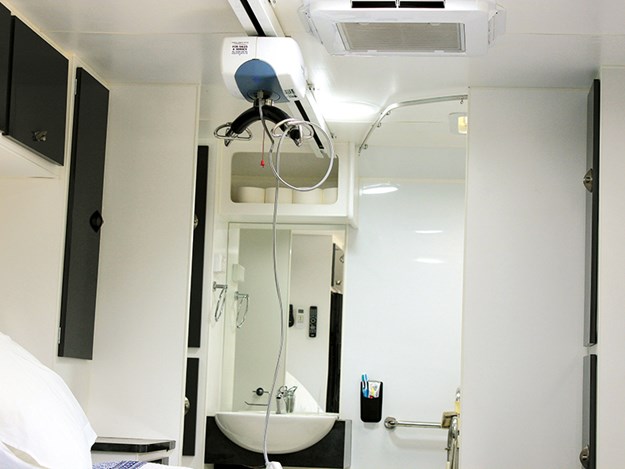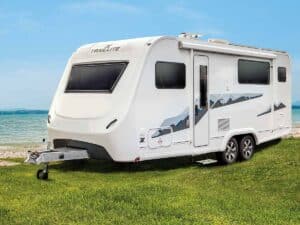
Evolution Caravans is an Australian manufacturer in the greater Melbourne regional area. What makes Evolution different to many other caravan makers is that custom building is their specialty, in particular making their vehicles wheelchair-friendly.
“A benefit of our vans is that they provide owners with an opportunity to travel around the country in the comfort of their own caravan. It is a home-away-from-home for wheelchair users,” says Evolution Caravans’ director, Ellen Shambrook.
“In many ways a purpose-built caravan is better than staying in a hotel or a motel – even a ‘wheelchair-friendly’ one – because there’s no doubt about what facilities will be available and what access might be like. Having a wheelchair-friendly caravan provides our customers with peace of mind.”
About 50 percent of Evolution’s customers have previously owned a standard caravan but the other half were new to the caravanning lifestyle.
I chatted to two couples, Donna and Marc Cooper, and Pauline and Arthur O’Connor, both of whom have purchased Evolution-built caravans designed for their special needs.
 |
After almost five years, Marc has found a caravan to suit his and his family’s needs |
Donna and Marc Cooper
Marc has been using a wheelchair since 1998. He and his wife Donna have two children and wanted to embrace the RV lifestyle. Their problem was finding a manufacturer who was willing to design a caravan for their specific needs. “We must have spent over five years looking for a caravan that would suit us as a family, and Marc in particular,” says Donna.
In addition to the potential layout challenges, there was one additional issue. The Coopers own a Volkswagen Multivan which is specially modified to take Marc’s wheelchair and that has a maximum towing weight of 2500kg. That might not sound so much of a problem in New Zealand, but it certainly is in Australia. Part of the modifications to the VW include air shock absorbers which can be used to raise and lower the height of the van.
But things quickly got sorted when they found Evolution Caravans and spoke with owner Bob Ali.
“We weren’t able to visit the factory often, so we spent a bit of time on the phone and over email working with Evolution on a design that would both work for us and be practical,” says Donna. “Bob was very helpful and offered lots of good advice.”
The result was an Evolution Lux-Accessible caravan that is 6300mm long with an ATM of 2500kg. ATM is the ‘aggregate trailer mass’, which is the total maximum permitted mass of the caravan when it is fully loaded (with luggage, water etc). With a tare weight of 1600kg, that gives 900kg of payload, a very impressive figure.
Inside, the layout consists of two bunks across the front wall, a kitchen bench directly opposite the entry door, an east-west bed in the rear section and full-width bathroom across the rear. There isn’t a dinette of any sort, but the double bunks are designed to be used as a seat as well as beds. Apart from the layout, the most obvious clue that this van is impressively different is the ceiling hoist that runs down the middle. is is something that requires modifications to the caravan framework.
 |
The wheelchair ramp on the Coopers’ van |
From the outside, you can see this caravan is different by the extra-wide door, a pull-out platform complete with corner stabilisers, and the wheelchair ramp. One feature the Coopers did ask for is an external slide-out kitchen up front, which makes al fresco living much more attractive. As a confident caravanner, Donna does most of the driving, although Marc drives occasionally. “We have owned the van for a couple of years now but haven’t had the opportunity to go on any major trips, mostly because we still have children at school.
That said, we have enjoyed trips to the Warrumbungles (western New South Wales), Batemans Bay and Huskisson (southern NSW). “As our children get older, we are very much looking forward to trips further a eld,” says Donna. “But what is really unbelievable about our purpose-built caravan is that we can now do something I never thought we would be able to!”
Pauline and Arthur O’Connor
Arthur O’Connor has been increasingly dependent on his wheelchair following an industrial accident nearly 40 years ago. Up until about six years ago, Arthur and his wife Pauline were able to enjoy the caravanning lifestyle, their last standard van being a 6.7-metre Jayco Heritage.
However, with getting in and out of the van becoming increasingly difficult, it looked like caravanning was coming to an end. But Arthur will tell you he’s a stubborn kind of man and wasn’t going to give up that easily.
 |
Everything is designed for easy wheelchair access in the O’Connors’ van |
The couple spotted a magazine advertisement for Evolution and started a dialogue with owner Bob. Like the Coopers, Pauline and Arthur didn’t visit the factory but conducted much of the design process over the phone and by email. The Cooper van has an external length of 6300mm and a loaded weight of about 2500kg, which makes it ideal for the Nissan Navara 4WD tow vehicle. Both Arthur and Pauline can competently tow the van, but Arthur does most of the driving.
Since Arthur has some mobility, the van layout consists of two front single beds, an offside lounge area with two swivelling captain’s chairs and a multifold table, a nearside kitchen, and a bathroom across the rear of the van. Everything is designed for easy wheelchair access, including the bathroom, where there’s plenty of room for getting in and out around the toilet and shower. Handrails are fitted to make moving around easier. Other wheelchair-friendly features include windows that wind out rather than push out, and switches and powerpoints that are set at a lower height.
 |
The east-west bed with its hoist |
For getting in and out of the van, there are ramps and a platform. The 2500mm aluminium chequer plate ramps were made in the USA and separate into four components for transporting on the rear bumper bar. The entry platform slideout from under the van is designed so that when not required, the conventional caravan step can be used. Pauline and Arthur are currently camped in Townsville, their ‘winter retreat’. “We normally come here every year and, fortunately, since we live in Victoria, we were able to get here before the Covid-19 border closures started. We’ve done a fair bit of travelling in our van to Perth, Darwin and Cairns, but Townsville is one of our favourites. “One of my hobbies is making miniature scale models on a lathe and I like to get to machinery rallies, where all kinds of machinery large and small is on display.”
 |
An alternative layout with a single bed mid van |
Up with the play
In order to get everything right, the Evolution team liaise with the Victorian Transport Accident Commission and the National Disability Insurance Scheme (NDIS) to ensure the latest design techniques are used. Although Evolution customises the vans it produces, the overall method of construction and fit-out is still common to all vans. A DuraGal box section chassis built to Evolution’s specification (including the wheelchair ramp) takes the weight, and all vans are fitted with tandem axles. Roller rocker leaf spring suspension is standard, but Tu Ride air bag suspension, and other off-road suspensions, are additional options.
 |
Bunk beds are an optional feature in Evolution’s vans |
Likewise, a ball coupling is standard and there are options such as an off-road Cruisemaster DO35/45. Meranti timber is used for the frame construction and that is beefed up when a ceiling hoist is fitted. Aluminium cladding is standard for the outside and, in keeping with everything else, there’s an option for aluminium composite panelling. Inside the van, the layout is one of personal choice as long as it’s practical. Single beds, bunks, double and queen beds are all available, as is custom seating. Items like hobs, fridges, microwave ovens and toilets are all standard industry products. The one-piece fibreglass moulded bathroom is certainly not a standard industry item, but at 1100mm x 780mm it suits customer needs.
 |
The Coopers’ bathroom easily accommodates a wheelchair |
Lightweight laminated plywood is used for all cabinetry work, with 12mm marine ply for the floor. Battery capacity is normally a 100AH deep cycle battery. That is boosted to two or three 120AH batteries when items like a 12-volt ceiling hoist, electric awning and/ or an entry access lift are fitted. For those who like to stay off the grid, two 150-watt solar panels are fitted.
 |
Hoists are handily located throughout |
 |
Arthur and Pauline weren’t willing to give up the RV lifestyle |
Summary
Although Australian-built caravans are often heavier than their New Zealand counterparts, it’s good to see that Evolution’s models are fitted with extra gear, while keeping the design in consideration and keeping the overall weight down. The Coopers and the O’Connors are clearly happy customers. Their purpose-built caravans gave them a new lease of life and way to get out and enjoy the RV lifestyle, just like everyone else.
 |
Single bed layout with wheelchair space beside the table |
For more, see evolutioncaravans.com.au





